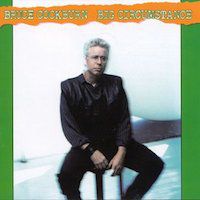 The result of three years of traveling to such far-flung places as Mozambique, Nepal and Central America, the songs on 1989’s Big Circumstance reflect Bruce Cockburn’s heartfelt reactions to war, repression and environmental abuse. The celebrated Canadian singer-songwriter was already well known for such forthright songs of the 1980s as “If I Had a Rocket Launcher” and “Call it Democracy.” With Big Circumstance, Cockburn ended the decade with some of the most politically potent material of his career, including “If a Tree Falls,” which tackled the issue of rain forest destruction. “From Sarawak to Amazonas, Costa Rica to mangy B.C. hills,” he sang angrily, “ancient cord of coexistence hacked by parasitic greedhead scam.” The accompanying video—one of Cockburn’s best—didn’t pull any punches either.
The result of three years of traveling to such far-flung places as Mozambique, Nepal and Central America, the songs on 1989’s Big Circumstance reflect Bruce Cockburn’s heartfelt reactions to war, repression and environmental abuse. The celebrated Canadian singer-songwriter was already well known for such forthright songs of the 1980s as “If I Had a Rocket Launcher” and “Call it Democracy.” With Big Circumstance, Cockburn ended the decade with some of the most politically potent material of his career, including “If a Tree Falls,” which tackled the issue of rain forest destruction. “From Sarawak to Amazonas, Costa Rica to mangy B.C. hills,” he sang angrily, “ancient cord of coexistence hacked by parasitic greedhead scam.” The accompanying video—one of Cockburn’s best—didn’t pull any punches either.
Gordon Lightfoot Book, Music and More!
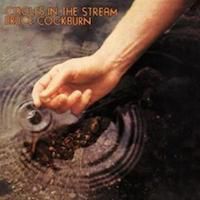 One of the marks of a great live album is the ability of the artist to inject his material with new vitality, to the point where even well-known songs take on fresh meaning. Bruce Cockburn did exactly that with Circles in the Stream, which caught the Canadian folksinger at the culmination of his first tour with a full band. That group provided the kind of intelligent and intuitive accompaniment that creates an inspired—and inspiring—concert experience. “It’s amazing to hear how tight we are together,” percussionist Bill Usher once recalled, on hearing the recording. “We’re all hitting the same accents at the same time and in harness with each other.”
One of the marks of a great live album is the ability of the artist to inject his material with new vitality, to the point where even well-known songs take on fresh meaning. Bruce Cockburn did exactly that with Circles in the Stream, which caught the Canadian folksinger at the culmination of his first tour with a full band. That group provided the kind of intelligent and intuitive accompaniment that creates an inspired—and inspiring—concert experience. “It’s amazing to hear how tight we are together,” percussionist Bill Usher once recalled, on hearing the recording. “We’re all hitting the same accents at the same time and in harness with each other.”
Recorded in the spring of 1977 at Toronto’s venerable Massey Hall, Circles in the Stream captures Cockburn at the peak of his creative powers. Originally released shortly after Cockburn’s fine transitional album In the Falling Dark, the live recording blends adventurous jazz textures with his more familiar folk influences. The album opens with the stirring sound of a traditional Scottish tune on bagpipes, before Cockburn and his sidemen—Usher, bassist Robert Boucher and electric pianist and marimba player Pat Godfrey—segue into a shimmering rendition of “Starwheel.” Following a marimba-laced version of the stark “Never So Free,” Cockburn launches into three newly written songs: the stunning guitar instrumental “Deer Dancing Round a Broken Mirror,” the dreamy, jazz-tinged French song “Homme Brûlant (Burning Man)” and the rhythmic, politically charged number “Free to Be.”
Two other new songs rank among the album’s highlights. Like “Deer Dancing,” the wondrously intricate instrumental “Cader Idris,” named after a Welsh mountain which means “Chair of Idris,” showcases Cockburn’s superb fingerpicking and fretwork. “Red Brother Red Sister” acknowledges the historic
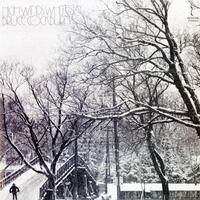 The stark black and white cover photo speaks volumes about Bruce Cockburn in the early 1970s. He stands alone at the foot of a bridge, surrounded by snow-capped trees, looking like what writer Jack Batten then described as a “splendid survivor of Robin Hood’s merry men dressed in leather jerkins and boot-high moccasins.” At the time, the rising singer-songwriter possessed a deep fascination with the wilderness and things medieval—especially Renaissance music. And although already on a quest, Cockburn had not yet embraced his particular brand of Christianity. He was, in his own words, a “spiritual loner who sought truth in nature.”
The stark black and white cover photo speaks volumes about Bruce Cockburn in the early 1970s. He stands alone at the foot of a bridge, surrounded by snow-capped trees, looking like what writer Jack Batten then described as a “splendid survivor of Robin Hood’s merry men dressed in leather jerkins and boot-high moccasins.” At the time, the rising singer-songwriter possessed a deep fascination with the wilderness and things medieval—especially Renaissance music. And although already on a quest, Cockburn had not yet embraced his particular brand of Christianity. He was, in his own words, a “spiritual loner who sought truth in nature.”
Images and references to rivers, birds, mountains and, especially, sunlight abound on 1971’s High Winds White Sky—as they do on Cockburn’s previous self-titled debut album and the subsequent Sunwheel Dance. The three albums formed a powerful acoustic trilogy that established Cockburn as one of Canada’s most important performers of introspective, literate songs. Unfortunately, they also typecast him as a pastoral folkie, an image that Cockburn found ultimately restricting. For one thing, his tastes went well beyond just folk into country blues and global music. And his interests led him to Buddhist teachings, from the Beat writers to the Sutras themselves. Blending all of those elements, High Winds White Sky remains a landmark recording—as fresh and
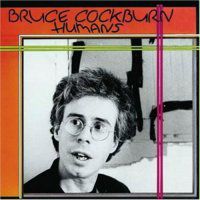 Ranked by many people as Bruce Cockburn’s best album, Humans is a watershed release in the acclaimed Canadian singer-songwriter’s stellar career. It came in the midst of tumultuous change in Cockburn’s life, following the breakup of his 10-year marriage and his move from the country to the city. After a decade of rural existence, living in a camper and then settling in tiny Burritt’s Rapids, south of Ottawa, the longtime loner took up residence in downtown Toronto. It was, he told reporters at the time, a deliberate test of his faith. “I moved with the express purpose of absorbing myself in human society to see what it was,” said Cockburn. “If, as a Christian, I was being asked to love my fellow human beings, I couldn’t love them very well if I didn’t know anything about them.”
Ranked by many people as Bruce Cockburn’s best album, Humans is a watershed release in the acclaimed Canadian singer-songwriter’s stellar career. It came in the midst of tumultuous change in Cockburn’s life, following the breakup of his 10-year marriage and his move from the country to the city. After a decade of rural existence, living in a camper and then settling in tiny Burritt’s Rapids, south of Ottawa, the longtime loner took up residence in downtown Toronto. It was, he told reporters at the time, a deliberate test of his faith. “I moved with the express purpose of absorbing myself in human society to see what it was,” said Cockburn. “If, as a Christian, I was being asked to love my fellow human beings, I couldn’t love them very well if I didn’t know anything about them.”
With 1980’s Humans, Cockburn challenged himself musically as well as spiritually. The album represented the first of his more electric, rock-oriented releases, after the trilogy of acoustic jazz folk recordings that culminated in 1979’s Dancing in the Dragon’s Jaws. The latter produced the reggae-flavored “Wondering Where the Lions Are,” which became a Top 40 hit in both Canada and the United States. Where “Lions” featured the rhythm section of Jamaican star Leroy Sibbles’ group, Humans’ anthemic “Rumours of Glory,” with its bouncy bass, added the reggae legend himself on backup vocals. Cockburn, wielding an electric guitar and backed by such new band members as violinist Hugh Marsh and keyboardist Jon Goldsmith, infused the entire album with a tougher, more uptempo sound. “I really wanted to play reggae music and rock ’n’ roll,” he
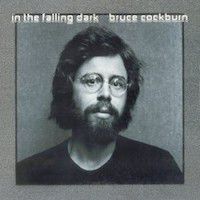 If an artist’s worth can be gauged by the degree to which his artistry evolves, then Bruce Cockburn’s value has grown immeasurably with each passing album. Over the course of 32 years and nearly as many recordings, the legendary Canadian singer-songwriter has always pushed the musical envelope. Never one to rest on his creative laurels, he has constantly tried on new ideas without ever abandoning the fabric of earlier material. The result is a rich body of work—deep, diverse and never disappointing—that stands the test of time and includes some of the most sophisticated and evocative songs in pop music.
If an artist’s worth can be gauged by the degree to which his artistry evolves, then Bruce Cockburn’s value has grown immeasurably with each passing album. Over the course of 32 years and nearly as many recordings, the legendary Canadian singer-songwriter has always pushed the musical envelope. Never one to rest on his creative laurels, he has constantly tried on new ideas without ever abandoning the fabric of earlier material. The result is a rich body of work—deep, diverse and never disappointing—that stands the test of time and includes some of the most sophisticated and evocative songs in pop music.
Originally released in 1976, In the Falling Dark was the first of a trilogy of recordings that bridged Cockburn’s acoustic work of the early ’70s with his electric period a decade later. Stylistically adventurous, it featured more jazz textures than folk influences, reflecting Cockburn’s long-time love of John Coltrane and Wes Montgomery, and showcased the daring, improvisational interplay of flute and horns. In the Falling Dark was also the first collection of songs that fully explored Cockburn’s deepening Christian faith, with numerous songs of praise and worship. But, far from fundamentalist or evangelical in tone, those songs—like all of his spiritual material—could be



